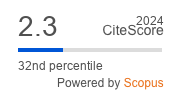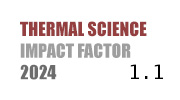THERMAL SCIENCE
International Scientific Journal
Thermal Science - Online First
online first only
Cycle analysis of a single-stage transcritical R744 system in supermarkets: The impact of isentropic efficiency and oil
ABSTRACT
Carbon dioxide is increasingly present in modern refrigeration systems, finding significant application in commercial cooling, especially in supermarkets. However, its application encounters many challenges due to its unfavorable thermodynamic properties. This serves as a starting point for numerous engineering solutions, as well as for many theoretical and experimental analyses of various systems utilizing R744. Some analyses often overlook the fact that, in addition to the refrigerant, oil also passes through all the system components in a certain quantity, which subsequently impacts heat transfer as well as the cycle itself. This paper presents a cycle analysis of a typical single-stage transcritical CO2 system used for medium-temperature (MT) cooling applications in a supermarket. The analysis included the impact of oil, considering several realistic steady-state scenarios with predicted OCR (Oil Circulation Ratio) values. In addition to the effect of oil, the study was expanded by examining available equations for the isentropic efficiency of the compressor. The results showed that considering a realistic compression process leads to an efficiency reduction of 15.4% to 39.9%, while the presence of oil decreases it by 5.7% to 27.8% under varying conditions.
KEYWORDS
PAPER SUBMITTED: 2025-03-15
PAPER REVISED: 2025-06-20
PAPER ACCEPTED: 2025-07-18
PUBLISHED ONLINE: 2025-08-02
- Lorentzen, G., Pettersen, J., A new, efficient and environmentally benign system for car air-conditioning, International Journal of Refrigeration, 16 (1993), 1, pp. 4-12
- Lorentzen, G., Revival of carbon dioxide as a refrigerant, International Journal of Refrigeration, 17 (1994), 5, pp. 292-301
- Kim, M. H., et al., Fundamental process and system design issues in CO2 vapor compression systems, Progress in Energy and Combustion Science, 30 (2004), 2, pp. 119-174
- Bansal, P., A review - Status of CO2 as a low temperature refrigerant: Fundamentals and R&D opportunities, Applied Thermal Engineering, 41 (2012), pp. 18-29
- Ma, Y., et al., A review of transcritical carbon dioxide heat pump and refrigeration cycles, Energy, 55 (2013), pp. 156-172
- Llopis, R., et al., Subcooling methods for CO2 refrigeration cycles: A review, International Journal of Refrigeration, 93 (2018), pp. 85-107
- Rony, R. U., et al., Recent Advances in Transcritical CO2 (R744) Heat Pump System: A Review, Energies, 12 (2019), 3, pp. 457
- Yu, B., et al., An updated review of recent advances on modified technologies in transcritical CO2 refrigeration cycle, Energy, 189 (2019), 116147
- Song, Y., et al., Advanced development and application of transcritical CO2 refrigeration and heat pump technology - A review, Energy Reports, 8 (2022), pp. 7840-7869
- Gullo, P., et al., Transcritical R744 refrigeration systems for supermarket applications: Current status and future perspectives, International Journal of Refrigeration, 93 (2018), pp. 269-310
- Ge, Y. T., Tassou, S. A., Thermodynamic analysis of transcritical CO2 booster refrigeration systems in supermarket, Energy Conversion and Management, 52 (2011), 4, pp. 1868-1875
- Sun, J., et al., Low global warming potential (GWP) refrigerant supermarket refrigeration system modeling and its application, International Journal of Refrigeration, 126 (2021), pp. 195-209
- Wang, K., et al., Review of secondary loop refrigeration systems, International Journal of Refrigeration, 33 (2010), 2, pp. 212-234
- Cabello, R., et al., Energy comparison based on experimental results of a cascade refrigeration system pairing R744 with R134a, R1234ze(E) and the natural refrigerants R290, R1270, R600a, International Journal of Refrigeration, 148 (2023), pp. 131-142
- Yilmaz, D., et al., The performance evaluation of R744 transcritical ejector and R290/R744 cascade refrigeration systems for Turkey, Thermal Science, 23 (2019), 6B, pp. 4031-4041
- Mitsopoulos, G., et al., Annual performance of a supermarket refrigeration system using different configurations with CO2 refrigerant, Energy Conversion and Management: X, 1 (2019), 100006
- Gullo, P., et al., Multi-ejector R744 booster refrigerating plant and air conditioning system integration - A theoretical evaluation of energy benefits for supermarket applications, International Journal of Refrigeration, 75 (2017), pp. 164-176
- Sharma, V., et al., Comparative analysis of various CO2 configurations in supermarket refrigeration systems, International Journal of Refrigeration, 46 (2014), pp. 86-99
- Thome, J. R., Comprehensive Thermodynamic Approach to Modeling Refrigerant-Lubricating Oil Mixtures, HVAC&R Research, 1 (1995), 2, pp. 110-125
- Zhang, W., et al., Theoretical and experimental investigation on the effects of internal heat exchangers on a reversible automobile R744 air-conditioning system under various operating conditions, Applied Thermal Engineering, 236 (2024), 121569
- Zhu, J., et al., Experimental investigation and theoretical analysis of oil circulation rates in ejector cooling cycles, Energy, 157 (2018), pp. 718-733
- Li, K., et al., An experimental investigation of oil circulation ratio influence on heating performance in an air condition heat pump system for electric vehicles, International Journal of Refrigeration, 122 (2021), pp. 220-231
- Tang, Z., et al., Operational stability influenced by lubricant oil charge in the CO2 automotive air conditioning system, International Journal of Refrigeration, 158 (2024), pp. 58-67
- Feja, S., Hanzelmann, C., Experimental studies of thermodynamic properties of R744-oil-mixtures up to 140 °C and 150 bar, International Journal of Refrigeration, 60 (2015), pp. 135-141
- Domin, D., et al., Thermodynamic property model of a partially miscible CO2-PAG68 mixture, Proceedings, 10th IIR Conference: Ammonia and CO2 Refrigeration Technologies, Ohrid, North Macedonia, 2023, pp. 163-172
- Feja, S., et al., Determination and evaluation of thermodynamic properties of a refrigeration oil with CO2 (Daniel Plot), Proceedings, 10th IIR Conference: Ammonia and CO2 Refrigeration Technologies, Ohrid, North Macedonia, 2023, pp. 173-182
- Direk, M., Kelesoglu, A., Automotive air conditioning system with an internal heat exchanger using R1234yf and different evaporation and condensation temperatures, Thermal Science, 23 (2019), 2B, pp. 1115-1125
- Liao, S. M., et al., A correlation of optimal heat rejection pressures in transcritical carbon dioxide cycles, Applied Thermal Engineering, 20 (2000), 9, pp. 831-841
- Aprea, C., Maiorino, A., Heat rejection pressure optimization for a carbon dioxide split system: An experimental study, Applied Energy, 86 (2009), 11, pp. 2373-2380
- Casson, V., et al., Optimisation of the throttling system in a CO2 refrigerating machine, International Journal of Refrigeration, 26 (2003), 8, pp. 926-935
- Ivanović, M., et al., Investigation of key parameters for optimizing high pressure in a single-stage transcritical CO2 system, Proceedings, 55th International HVAC&R Congress and Exhibition, Belgrade, Serbia, 2024 (in Serbian)
- Brown, J. S., et al., Comparative analysis of an automotive air conditioning systems operating with CO2 and R134a, International Journal of Refrigeration, 25 (2002), 1, pp. 19-32
- Wang, S., et al., Experimental investigation on air-source transcritical CO2 heat pump water heater system at a fixed water inlet temperature, International Journal of Refrigeration, 36 (2013), 3, pp. 701-716
- Qin, X., et al., A study on the compressor frequency and optimal discharge pressure of the transcritical CO2 heat pump system, International Journal of Refrigeration, 99 (2019), pp. 101-113
- Černicin, V., et al., The difference between simplified theoretical and experimental cycle analysis of CO2 heat pump, Proceedings, 10th IIR Conference: Ammonia and CO2 Refrigeration Technologies, Ohrid, North Macedonia, 2023, pp. 230-237
- Robinson, D. M., Groll, E. A., Efficiencies of transcritical CO2 cycles with and without an expansion turbine, International Journal of Refrigeration, 21 (1998), 7, pp. 577-589

